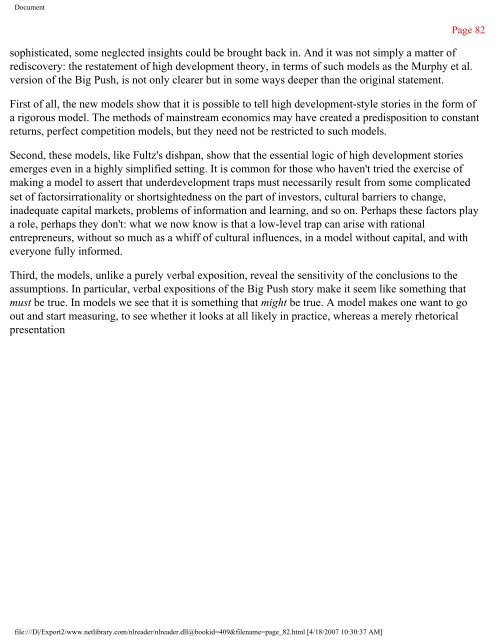Document file:///D|/Export1/www.netlibrary.com/nlreader/nlreader.dll ...
Document file:///D|/Export1/www.netlibrary.com/nlreader/nlreader.dll ...
Document file:///D|/Export1/www.netlibrary.com/nlreader/nlreader.dll ...
You also want an ePaper? Increase the reach of your titles
YUMPU automatically turns print PDFs into web optimized ePapers that Google loves.
<strong>Document</strong><br />
sophisticated, some neglected insights could be brought back in. And it was not simply a matter of<br />
rediscovery: the restatement of high development theory, in terms of such models as the Murphy et al.<br />
version of the Big Push, is not only clearer but in some ways deeper than the original statement.<br />
Page 82<br />
First of all, the new models show that it is possible to tell high development-style stories in the form of<br />
a rigorous model. The methods of mainstream economics may have created a predisposition to constant<br />
returns, perfect <strong>com</strong>petition models, but they need not be restricted to such models.<br />
Second, these models, like Fultz's dishpan, show that the essential logic of high development stories<br />
emerges even in a highly simplified setting. It is <strong>com</strong>mon for those who haven't tried the exercise of<br />
making a model to assert that underdevelopment traps must necessarily result from some <strong>com</strong>plicated<br />
set of factors irrationality or shortsightedness on the part of investors, cultural barriers to change,<br />
inadequate capital markets, problems of information and learning, and so on. Perhaps these factors play<br />
a role, perhaps they don't: what we now know is that a low-level trap can arise with rational<br />
entrepreneurs, without so much as a whiff of cultural influences, in a model without capital, and with<br />
everyone fully informed.<br />
Third, the models, unlike a purely verbal exposition, reveal the sensitivity of the conclusions to the<br />
assumptions. In particular, verbal expositions of the Big Push story make it seem like something that<br />
must be true. In models we see that it is something that might be true. A model makes one want to go<br />
out and start measuring, to see whether it looks at all likely in practice, whereas a merely rhetorical<br />
presentation<br />
<strong>file</strong>:///<strong>D|</strong>/Export2/<strong>www</strong>.<strong>netlibrary</strong>.<strong>com</strong>/<strong>nlreader</strong>/<strong>nlreader</strong>.<strong>dll</strong>@bookid=409&<strong>file</strong>name=page_82.html [4/18/2007 10:30:37 AM]
















